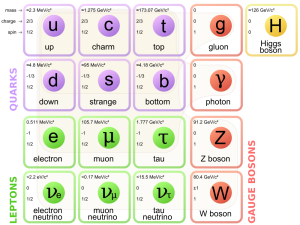The ATLAS experiment at CERN has for the first time found a real difference between the way the higgs particle decays to charm quarks or botton quarks. Such a difference had been expected, but had not been measured until now.
The higgs particle found in 2012 theoretically maintains a relationship with particles and quarks that is proportional to their mass. This has been measured for heavy particles such as the top quark and the tau particle. Coupling with the relatively heavy bottom quark has also been measured. But for lighter quarks like charm, the uncertainty is still large.
Not equal
The new analysis shows that the coupling of the charm quark with the higgs particle is in any case not equal or greater than the coupling with the heavier bottom quark. For this estimate, techniques were used that were developed by researchers at Nikhef, among others.
These look at the ratio of decays to bottom and to charm. In this way, some uncertainties in the individual measurements cancel each other out. “That gives more guidance than individual measurements,” says Tristan du Pree of Nikhef, who is leading the analyses by PhD students from the UvA Brian Moser and Marco Stamenkovic, among others.
Jets of particles
ATLAS is one of two large detectors at CERN that watch for colliding protons in the LHC accelerator. Nikhef has been cooperating intensively in the ATLAS project from the beginning.

The decays are measured using so-called jets of particles, which originate from the quark pairs into which a Higgs particle decays. Such jets of particles from botton and charm are so similar that jets are sometimes attributed to the wrong process. By combining measurements, this has less influence on the measurement results.
The present result shows that the coupling of higgs to charm quarks is definitely smaller than to bottom quarks. This is also what the standard model predicts. Charm quarks are three times lighter than bottom quarks.
Three generations
The couplings of the higgs particle with the other particles is one of properties that has been studied since the particle’s discovery. The measurements may be able to clarify why there are three generations of matter particles (quarks and leptons) in the standard model, which differ mainly in their mass.
Ordinary matter consists of electrons plus protons and neutrons that are combinations of three of the light quarks, up and down. The Higgs couplings of that lightest generation of particles have never been measured.
Translated with www.DeepL.com/Translator (free version)